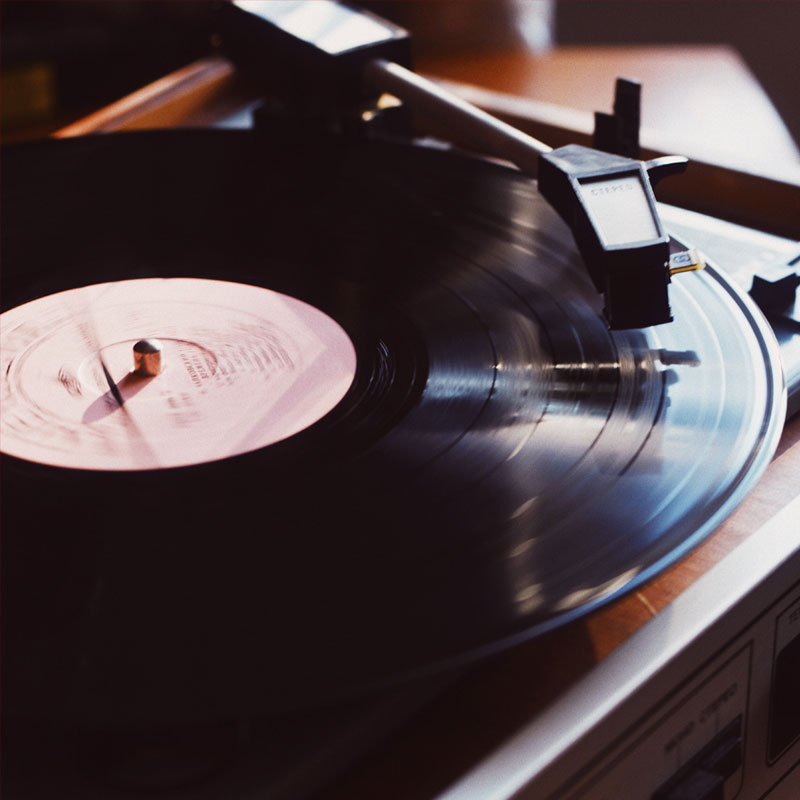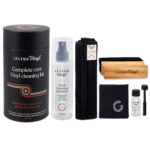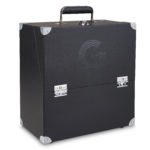Driven as vinyl record collectors are by their swellings of passion for this most exclusive of hobbies, there are points of contention between fellow enthusiasts at almost every turn. This is true even down to the smallest of additions and accessories in one’s vinyl tool belt.
The record weight might seem like a no brainer to some collectors, whereas for others it can just seem like a pain – each, of course, are accompanied by their own various pros and cons, and it is those that we will be discussing here today.
Since all of us record enthusiasts are coming into this world with similar motives and passions for music, no matter how these came about in the first place, you’d think there would be more blanket agreement across the board when it comes to the personal preferences of said enthusiasts. Humans, however, are fickle beasts and will honour their own specific inclinations and predilections to the bitter end.
A tool such as this is falling under the broad category of minor tweaks that you might add to your set up to make some minor adjustments, as opposed to the full scale upgrading of a specific unit in your stereo, for example.

What Exactly is a Record Weight?
In talking about the record weight as a concept, the term will come to mean any device of any variety that is broadly used to weigh down the record during playback, to stabilise the vinyl disc while being operated. There are a whole host of variants under this broad umbrella, (record clamp, turntable clamp, turntable weight, record weight stabiliser, vinyl record weight etc) almost all of which are seeking to do roughly the same thing.
Many often think of the record weight and clamp styles as the end of this area of audiophilia, though there are in fact other options, even if they do occupy the higher end of the price range for vinyl record stabilisation.
A turntable ring, for example, rests on the outer lip of the record, grounding it to the movement of the turntable. Those that are made of stainless steel does the coupling and is particularly effective at grounding warped records.
On the other hand, we have a turntable vacuum, which if anything stands as testament to just how far audiophiles are willing to take the concept of vinyl disc stabilisation and of how much importance is placed on it by said audiophiles. These are far rarer as a method of disc stabilisation, for they provide literal suction of the disc in question to the platter of the turntable, in theory exerting an equal amount of suction all over the disc and meaning that the height of the disc is perfectly stabilised.
Dampening of Vibrations
At the most simple level, the added mass of the record weight (the clue being in the title) reduces undesirable vibrations that might otherwise transfer to the stylus while the record is spinning and playing back.
No doubt there have been plenty of instances where the movements of people in the room have transferred to the sound of the disc in action; the tell tale signs are a rumbling transmitting through the speaker. A record weight seeks to eradicate these vibrations transmitted from the outside that might otherwise contaminate a perfect audiophilic listening experience.
By creating better contact between the record and platter as the stylus tracks the grooves of the spinning record, the record weight can reduce vibrations, distortion, and result in cleaner playback.
Prevention of Slipping
Depending on the hole in the centre of the record and how snugly it fits onto the spool at the middle of the turntable platter, the disc is prone to the possibility of slipping. When this happens, there will be an obvious adjustment of pitch, an adjustment so obvious that anyone could hear it. For an audiophile this is seriously unacceptable.
A record weight can help with this, adding a weight that significantly reduces the risk of this happening, negating the need to purchase a fancy specialised turntable mat or a whole new turntable altogether with a new spool on the platter. This is an obvious solution to an obvious problem, a problem that just about anyone with ears would be able to spot.
Wow and Flutter
Closely related to this concept is the hinderance of what is commonly referred to as wow and flutter. Some vinyl record collectors claim that adding a record weight atop a disc atop a turntable platter spinning helps to improve the speed stability of the spinning, meaning the sound will be played at a more constant rate as a result of the additional mass atop the disc.
While there are certainly notions of physics that support such claims, the difference is likely to rather negligible, so this line of inquiry is reserved for those true audiophiles in whose brains these issues play out like PTSD fever dreams.
Dealing with the Problem of Warped Records
There are plenty of ways for a vinyl record collector to reduce the warping of their records, there is an ever increasing trend of records arriving even from the factory already warped. No doubt this is, at least in part, due to the increasing strain placed on record pressing factories as a result of the vinyl boom of the last ten or so years.
It is, indeed, rare to come across a newly pressed record that is totally without faults, large or small. I recently received a reissue copy of Hex Enduction Hour by The Fall which looked more like a potato chip than a vinyl record. And even if you do receive the disc in pristine condition, there are innumerable environmental and ambient factors that can affect the shape of the record over time.
For example, if you were to leave your records in a space that builds up enough heat and humidity and moisture, then certain records are likely to warp to varying degrees, from barely noticeable right through to unplayable. These conditions certainly affect some records more than others, though these possibilities should really be avoided at all costs.
Records that are only slightly warped and that are still playable will still put strain on the needle and the stylus over time, forcing it to climb up and down the warps repeatedly in order to stay at a constant pitch and speed. In these instances, a record weight is able to step in to temporarily to level the playing surface, meaning that the stylus can optimally track the grooves of these slightly warped records, improving playback and the overall health of the turntable and its appendages.
It is important to note, however, that a record weight will not flatten a severely warped record to its original flatness, nor will it fix slightly warped records. If this can be done at all it is best left to professionals, though it is far more likely that you will simply have to buy another copy of the record.
Should I Buy a Record Clamp or Record Weight?
Depending on who you are asking you are almost certainly going to receive a whole host of different answers to this question, and both certainly have their own benefits and their own disadvantages.
Record clamps, for example, are believed to have the added advantage of securing the record in place without having to exert as much additional weight. This will certainly be more important to those worried in the first place about the additional strain that a record weight might exert on the inner components of the turntable. Inversely, however, in using a clamp one is subscribing inherently to a longer amount of time between the switching of discs, so secure is this clamping mechanism sometimes.
For many artists and disc jockeys this simply will not do, especially when you consider the possible risk of damage if you were to, for example, over tighten the clamping mechanism or if your hand were to slip onto the record. In this instance, the record weight surely seems like the route to take, providing the consumer with swift change overs and relative stability of playback.
Final Tones
So, there you have it, a comprehensive and, I hope, useful guide with which to navigate the minutiae of audiophilia, so that you may tweak your home setup with tools like the record weight and achieve the perfect sound for your stereo, regardless of how warped your records might sometimes be or the various downfalls of the vinyl record collecting medium for playback of sound.
FAQs Record Weight
A record weight is an accessory for turntable enthusiasts, vinyl record collectors, and audiophiles, often coming in the shape of a hockey puck that is specifically weighted to weigh down a record for various reasons. Some use a record weight to dampen the extraneous vibrations that can be transmitted through the floor and surrounding area into the needle and out through the speakers, nightmarish to the audiophile in all of us. Others use a record weight to weigh down a record so that the various warps it has accrued over its time can be flattened out during playback, putting less strain on the stylus over time, preventing it from having to overly exert itself. Still others use it to stabilise the speed of the record’s playback, and many more use the record weight for all three of these things and whole host of others.
This will very much vary on not only the product and the opinions of their manufacturers but also on the consumer and the reasons for your purchasing of the record weight in the first place. That being said, however, many will be only too quick to tell you how important it is to strike a middle ground between light and heavy record weights. The MasterSounds turntable weight, for example, is much revered by several disc jockeys, including the famous duo Bicep, for promoting ‘improved bass response, tighter mids and controlled highs. This particular piece of gear strikes the middle ground of weight, at just over 400 grams, importantly ‘light enough to not cause damage to a turntable’s bearing system, but heavy enough to give sonic improvement.’
This will very much vary on not only the product and the opinions of their manufacturers but also on the consumer and the reasons for your purchasing of the record weight in the first place. If you are inclined to utter audiophilia and notice all of the most minute faults when listening to a recording, both digital and analog, then a record weight is more than likely going to shine in your arsenal of equipment as an exemplar of the attention to detail that you tend to pay each microscopic point of interest in a recording. If, inversely, you aren’t particularly fussed by these minutiae then a record weight isn’t likely to be of much use to you, certainly not noticeably enough for it to be worth you spending the money on it.
There is a lot of talk of this being the case, and certainly it would be the case for all record weights were they all to be produced under the same parameters and with the same materials and the same intentions. However, if this wasn’t already obvious, this isn’t in fact the case, as many manufacturers are designing and creating these record weights with different purposes, intentions and materials at each and every point. The MasterSounds turntable weight, for example, is much revered by several disc jockeys, including the famous duo Bicep, for promoting ‘improved bass response, tighter mids and controlled highs. This particular piece of gear strikes the middle ground of weight, at just over 400 grams, importantly ‘light enough to not cause damage to a turntable’s bearing system, but heavy enough to give sonic improvement.’







